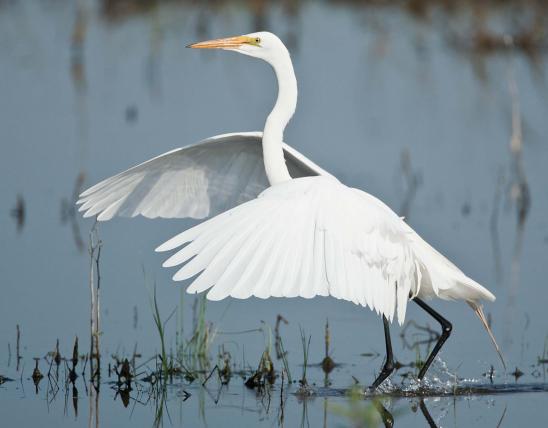
Cattle egrets are small, compact, stocky, white herons. Adults have yellow bills and legs; immatures have blackish legs. During the breeding season, the legs and bills become reddish, and the feathers of the head, breast, and back are buffy orange. Voice is short with single or multiple nasal quakes or moans.
Similar species: Adult cattle egrets are usually separated from great egrets, snowy egrets, and little blue herons by their small size, yellow bill, and yellow legs.
Length: 20 inches. Slightly larger than a green heron.

Statewide.
Habitat and Conservation
Usually forage in groups near their nesting colonies. Flocks forage in flooded crop fields, lawns, marshes, roadsides, and ditches as well as pastures, where they walk among livestock or even perch atop the backs of livestock. Less associated with streams than other herons. If you see small egrets foraging among cattle in a pasture, they are usually cattle egrets. Cattle egrets may join our other white herons in mixed foraging flocks at floodplain pools or appear singly at a lake or farm pond.
Food
Forage in flocks in grassy, open wet areas and pastures. They are famous for their habit of snatching insects that are stirred up by the grazing movements of cattle. But the diet is quite varied. In addition to grasshoppers, katydids, and crickets, they also eat horseflies, cicadas, ticks, worms, centipedes, spiders, crayfish, fish, frogs, mice, and even small birds, eggs, and nestlings.
Status
As a summer resident, locally common in southeast Missouri and casual elsewhere; as a migrant and summer (nonbreeding or postbreeding) visitor, uncommon statewide. This is a nonnative species. Originally from Africa and Asia, it was introduced to South America in the late 1800s. It spread northward, reaching the United States in 1941. Today, it is one of the most abundant herons in North America. Its range now extends north to Newfoundland and Alaska.
Life Cycle
Present in Missouri April through November. Like many other herons, this species nests in colonies. The nests are positioned in the branches of trees or shrubs in swamps or other wetlands. Both parents build the shallow, disorderly bowl nest from sticks and twigs. Clutches comprise 2–4 eggs, which are incubated for about four weeks. After hatching, the young stay at the nest another 2–3 weeks before fledging. Cattle egrets flock when they are nesting and when they are not nesting. They spend winters in the US Gulf Coast states, Mexico, Central America, and the Caribbean. A cattle egret can live for at least 17 years.
Human Connections
Cattle egrets likely arrived in the western hemisphere via transportation by humans, and their expansion was no doubt aided by humans’ altering the landscape for crops and livestock. To livestock holders, they can be welcome because of their habits of eating horseflies and other insect parasites of cattle.
Ecosystem Connections
Cattle egrets tend to accumulate water-borne pollutants in their feathers, so they may provide a way to gauge environmental pollution in some areas. Cattle egrets, and especially their eggs and young, are preyed upon by many kinds of animals.






















About 350 species of birds are likely to be seen in Missouri, though nearly 400 have been recorded within our borders. Most people know a bird when they see one — it has feathers, wings, and a bill. Birds are warm-blooded, and most species can fly. Many migrate hundreds or thousands of miles. Birds lay hard-shelled eggs (often in a nest), and the parents care for the young. Many communicate with songs and calls.


























